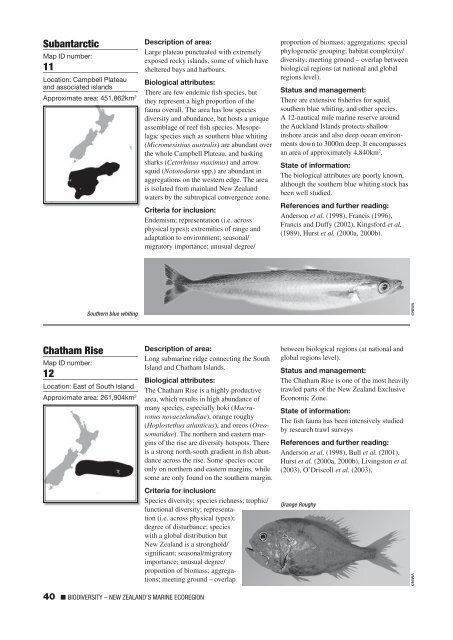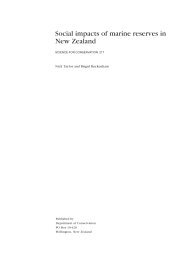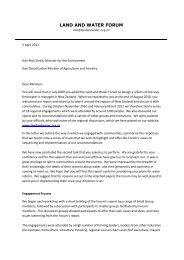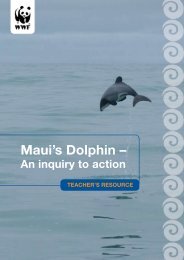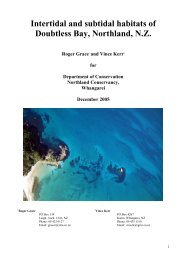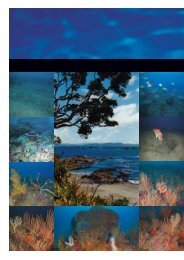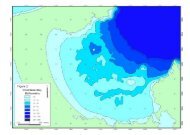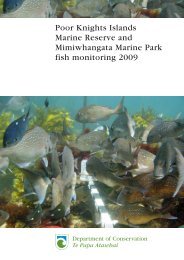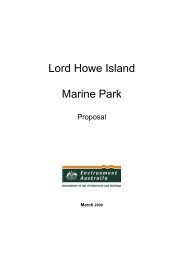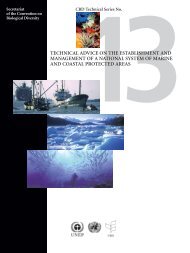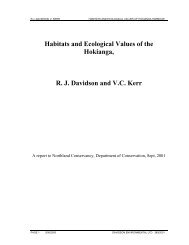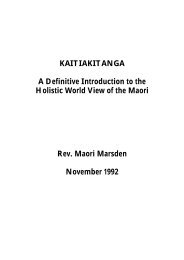WWF Shining a spotlight on the biodiversity of ... - MarineNZ.org.nz
WWF Shining a spotlight on the biodiversity of ... - MarineNZ.org.nz
WWF Shining a spotlight on the biodiversity of ... - MarineNZ.org.nz
Create successful ePaper yourself
Turn your PDF publications into a flip-book with our unique Google optimized e-Paper software.
Subantarctic<br />
Map ID number:<br />
11<br />
Locati<strong>on</strong>: Campbell Plateau<br />
and associated islands<br />
Approximate area: 451,862km 2<br />
Descripti<strong>on</strong> <strong>of</strong> area:<br />
Large plateau punctuated with extremely<br />
exposed rocky islands, some <strong>of</strong> which have<br />
sheltered bays and harbours.<br />
Biological attributes:<br />
There are few endemic fish species, but<br />
<strong>the</strong>y represent a high proporti<strong>on</strong> <strong>of</strong> <strong>the</strong><br />
fauna overall. The area has low species<br />
diversity and abundance, but hosts a unique<br />
assemblage <strong>of</strong> reef fish species. Mesopelagic<br />
species such as sou<strong>the</strong>rn blue whiting<br />
(Micromesistius australis) are abundant over<br />
<strong>the</strong> whole Campbell Plateau, and basking<br />
sharks (Cetorhinus maximus) and arrow<br />
squid (Nototodarus spp.) are abundant in<br />
aggregati<strong>on</strong>s <strong>on</strong> <strong>the</strong> western edge. The area<br />
is isolated from mainland New Zealand<br />
waters by <strong>the</strong> subtropical c<strong>on</strong>vergence z<strong>on</strong>e.<br />
Criteria for inclusi<strong>on</strong>:<br />
Endemism; representati<strong>on</strong> (i.e. across<br />
physical types); extremities <strong>of</strong> range and<br />
adaptati<strong>on</strong> to envir<strong>on</strong>ment; seas<strong>on</strong>al/<br />
migratory importance; unusual degree/<br />
proporti<strong>on</strong> <strong>of</strong> biomass; aggregati<strong>on</strong>s; special<br />
phylogenetic grouping; habitat complexity/<br />
diversity; meeting ground – overlap between<br />
biological regi<strong>on</strong>s (at nati<strong>on</strong>al and global<br />
regi<strong>on</strong>s level).<br />
Status and management:<br />
There are extensive fisheries for squid,<br />
sou<strong>the</strong>rn blue whiting, and o<strong>the</strong>r species.<br />
A 12-nautical mile marine reserve around<br />
<strong>the</strong> Auckland Islands protects shallow<br />
inshore areas and also deep ocean envir<strong>on</strong>ments<br />
down to 3000m deep. It encompasses<br />
an area <strong>of</strong> approximately 4,840km 2 .<br />
State <strong>of</strong> informati<strong>on</strong>:<br />
The biological attributes are poorly known,<br />
although <strong>the</strong> sou<strong>the</strong>rn blue whiting stock has<br />
been well studied.<br />
References and fur<strong>the</strong>r reading:<br />
Anders<strong>on</strong> et al. (1998), Francis (1996),<br />
Francis and Duffy (2002), Kingsford et al.<br />
(1989), Hurst et al. (2000a, 2000b).<br />
Sou<strong>the</strong>rn blue whiting<br />
©NIWA<br />
Chatham Rise<br />
Map ID number:<br />
12<br />
Locati<strong>on</strong>: East <strong>of</strong> South Island<br />
Approximate area: 261,904km 2<br />
Descripti<strong>on</strong> <strong>of</strong> area:<br />
L<strong>on</strong>g submarine ridge c<strong>on</strong>necting <strong>the</strong> South<br />
Island and Chatham Islands.<br />
Biological attributes:<br />
The Chatham Rise is a highly productive<br />
area, which results in high abundance <strong>of</strong><br />
many species, especially hoki (Macrur<strong>on</strong>us<br />
novaezelandiae), orange roughy<br />
(Hoplostethus atlanticus), and oreos (Oreosomatidae).<br />
The nor<strong>the</strong>rn and eastern margins<br />
<strong>of</strong> <strong>the</strong> rise are diversity hotspots. There<br />
is a str<strong>on</strong>g north-south gradient in fish abundance<br />
across <strong>the</strong> rise. Some species occur<br />
<strong>on</strong>ly <strong>on</strong> nor<strong>the</strong>rn and eastern margins, while<br />
some are <strong>on</strong>ly found <strong>on</strong> <strong>the</strong> sou<strong>the</strong>rn margin.<br />
Criteria for inclusi<strong>on</strong>:<br />
Species diversity; species richness; trophic/<br />
functi<strong>on</strong>al diversity; representati<strong>on</strong><br />
(i.e. across physical types);<br />
degree <strong>of</strong> disturbance; species<br />
with a global distributi<strong>on</strong> but<br />
New Zealand is a str<strong>on</strong>ghold/<br />
significant; seas<strong>on</strong>al/migratory<br />
importance; unusual degree/<br />
proporti<strong>on</strong> <strong>of</strong> biomass; aggregati<strong>on</strong>s;<br />
meeting ground – overlap<br />
between biological regi<strong>on</strong>s (at nati<strong>on</strong>al and<br />
global regi<strong>on</strong>s level).<br />
Status and management:<br />
The Chatham Rise is <strong>on</strong>e <strong>of</strong> <strong>the</strong> most heavily<br />
trawled parts <strong>of</strong> <strong>the</strong> New Zealand Exclusive<br />
Ec<strong>on</strong>omic Z<strong>on</strong>e.<br />
State <strong>of</strong> informati<strong>on</strong>:<br />
The fish fauna has been intensively studied<br />
by research trawl surveys<br />
References and fur<strong>the</strong>r reading:<br />
Anders<strong>on</strong> et al. (1998), Bull et al. (2001),<br />
Hurst et al. (2000a, 2000b), Livingst<strong>on</strong> et al.<br />
(2003), O’Driscoll et al. (2003).<br />
Orange Roughy<br />
©NIWA<br />
40 ■ BIODIVERSITY – NEW ZEALAND’S MARINE ECOREGION


